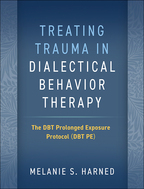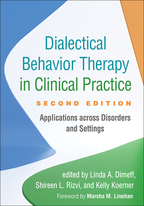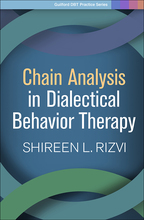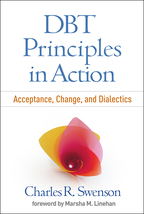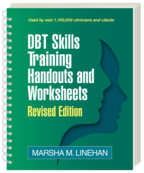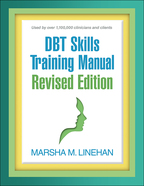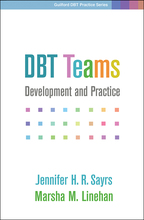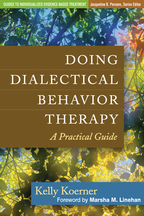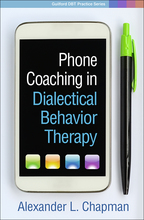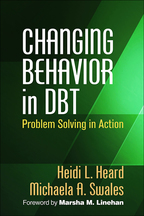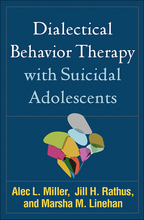Treating Trauma in Dialectical Behavior Therapy
The DBT Prolonged Exposure Protocol (DBT PE)
Melanie S. Harned
HardcoverPaperbacke-bookprint + e-book
Hardcover
orderMarch 23, 2022
ISBN 9781462549139
Price: $86.00 444 Pages
Size: 8" x 10½"
Paperback
orderApril 13, 2022
ISBN 9781462549122
Price: $57.00444 Pages
Size: 8" x 10½"
e-book
orderMarch 2, 2022
PDF and Accessible ePub ?
Price: $57.00 444 Pages
ePub is Global Certified Accessible
print + e-book $114.00 $68.40
orderPaperback + e-Book (PDF and Accessible ePub) ?
Price: 444 Pages
ePub is Global Certified Accessible
Check out Guilford Digital for DBT, the app that streamlines key aspects of DBT delivery and skills training, from customizable diary cards to Marsha Linehan's complete skills library.
Read a Q&A with featured author, Melanie S. Harned!
Sign up for emails on upcoming titles on Dialectical Behavior Therapy (DBT) (with special discounts)!
The reproducible materials can be downloaded and printed in PDF format.
“This book is excellent because it is written by the developer of DBT PE. The step-by-step approach enables clinicians to apply the method in various circumstances. The appendices contain valuable handouts for clients and forms for therapists. *****!”

—Doody's Review Service
“A well-organized, pragmatic, and user-friendly clinical handbook that takes the reader step by step from pre-treatment considerations to post-treatment next steps, providing detailed descriptions of each stage of treatment delivery. Treatment components, which clearly derive from evidence-based principles, are thoroughly explained, well supported, and practically illustrated with realistic clinical examples….This book is a useful clinical manual for psychotherapists who work with high-risk clients suffering from severe co-occurring emotion regulation and PTSD-related difficulties….The manual is engaging, encouraging, easy to understand, and solidly rooted in a strong evidence base. This manual will be found useful and appropriate for seasoned masters- and PhD-level clinicians, as well as graduate student trainees, who possess both interest in and familiarity with the sometimes challenging-to-treat population of clients with co-occurring emotion/behavioral dysregulation and PTSD.”

—Journal of Contemporary Psychotherapy
“On rare occasions, a work comes along that expands our basic assumptions, elevates our practice, improves client outcomes, and advances the field substantively. Harned’s DBT PE manual is just that work. DBT PE is a game changer for clients with trauma histories who need DBT, granting providers the ability to formally target PTSD. With a meticulously crafted rationale; precise, principle-based guidelines for conducting exposures; DBT-infused processing; targeted applications for numerous trauma types and populations (including adolescents, who thrive with her approach); and instructive handouts and worksheets, this manual is a brilliant addition to the field.”

—Jill H. Rathus, PhD, Department of Psychology, Long Island University Post; Cognitive Behavioral Associates, Great Neck, New York
“Harned has done a masterful job integrating DBT with PE and has conducted a body of research providing strong empirical support for this PTSD treatment. The manual thoroughly presents the theoretical underpinnings of DBT PE. It provides assessment guidelines, criteria for readiness for DBT PE, session procedures, and troubleshooting help. Harned describes how to work with clients after the final session of DBT PE, including ongoing exposure, relapse prevention, and Stage 3 DBT. A single case beautifully demonstrates implementation of DBT PE from beginning to end. This well-written treatment manual is suitable for trainees learning DBT PE as well as for very seasoned trauma therapists who wish to learn how to treat complex, high-risk patients with an effective, evidence-based treatment.”

— Elizabeth A. Hembree, PhD, Department of Psychiatry, Perelman School of Medicine, University of Pennsylvania
“The DBT PE protocol has been demonstrated to improve emotion regulation and reduce self-injurious behaviors in patients with severe PTSD who are not able to benefit from PE on its own. This comprehensive, eagerly awaited manual provides the details and logistics of DBT PE, with all necessary worksheets and session guidelines. Harned describes how the protocol was developed in a stepped manner to ensure safety and efficacy, providing a model for those involved in treatment development. This manual is an excellent fit for any setting where providers and clinical students in training are working to build on the foundations of DBT and/or PE to work effectively with highly comorbid and distressed patients. Harned does an excellent job of synthesizing the complexities of caring for these patients with validation, support, effective intervention, and empathy.”

—Sheila A. M. Rauch, PhD, ABPP, Mark and Barbara Klein Distinguished Professor in Psychiatry and Deputy Director, Emory Healthcare Veterans Program, Emory University School of Medicine
“Harned seamlessly integrates principles and protocols of PE into standard DBT—the synthesis is elegant as well as practical, clear as well as compassionate, behaviorally specific while allowing for flexibility. This highly readable manual walks therapists step by step through treatment of individuals who are haunted by traumatic memories and trapped in self-destructive patterns. Harned’s persistent optimism and encouragement will bolster the resolve of therapists and clients at a loss for what to do about trauma and PTSD. Most important, DBT PE has been shown to be amazingly effective. Every psychotherapist working with traumatized, difficult-to-treat populations should consider applying DBT PE to help their patients find lives of freedom and meaning.”

—Charles R. Swenson, MD, Department of Psychiatry, University of Massachusetts Medical School
“Treatment of PTSD in individuals who are suicidal is a conundrum for therapists; there has been little research to guide us. This book lays out for clinicians a route—with evidence behind it—for helping those with PTSD and suicidal behavior to achieve a life worth living. It is a rare treat to find a clinical manual that is this clear and well written. This book will become a well-loved resource on many clinicians’ bookshelves, and I foresee using it frequently with my own trainees, especially those on internship or at the postdoctoral level.”

—Debra Kaysen, PhD, ABPP, Department of Psychiatry and Behavioral Sciences, Stanford University
—Doody's Review Service
“A well-organized, pragmatic, and user-friendly clinical handbook that takes the reader step by step from pre-treatment considerations to post-treatment next steps, providing detailed descriptions of each stage of treatment delivery. Treatment components, which clearly derive from evidence-based principles, are thoroughly explained, well supported, and practically illustrated with realistic clinical examples….This book is a useful clinical manual for psychotherapists who work with high-risk clients suffering from severe co-occurring emotion regulation and PTSD-related difficulties….The manual is engaging, encouraging, easy to understand, and solidly rooted in a strong evidence base. This manual will be found useful and appropriate for seasoned masters- and PhD-level clinicians, as well as graduate student trainees, who possess both interest in and familiarity with the sometimes challenging-to-treat population of clients with co-occurring emotion/behavioral dysregulation and PTSD.”
—Journal of Contemporary Psychotherapy
“On rare occasions, a work comes along that expands our basic assumptions, elevates our practice, improves client outcomes, and advances the field substantively. Harned’s DBT PE manual is just that work. DBT PE is a game changer for clients with trauma histories who need DBT, granting providers the ability to formally target PTSD. With a meticulously crafted rationale; precise, principle-based guidelines for conducting exposures; DBT-infused processing; targeted applications for numerous trauma types and populations (including adolescents, who thrive with her approach); and instructive handouts and worksheets, this manual is a brilliant addition to the field.”
—Jill H. Rathus, PhD, Department of Psychology, Long Island University Post; Cognitive Behavioral Associates, Great Neck, New York
“Harned has done a masterful job integrating DBT with PE and has conducted a body of research providing strong empirical support for this PTSD treatment. The manual thoroughly presents the theoretical underpinnings of DBT PE. It provides assessment guidelines, criteria for readiness for DBT PE, session procedures, and troubleshooting help. Harned describes how to work with clients after the final session of DBT PE, including ongoing exposure, relapse prevention, and Stage 3 DBT. A single case beautifully demonstrates implementation of DBT PE from beginning to end. This well-written treatment manual is suitable for trainees learning DBT PE as well as for very seasoned trauma therapists who wish to learn how to treat complex, high-risk patients with an effective, evidence-based treatment.”
— Elizabeth A. Hembree, PhD, Department of Psychiatry, Perelman School of Medicine, University of Pennsylvania
“The DBT PE protocol has been demonstrated to improve emotion regulation and reduce self-injurious behaviors in patients with severe PTSD who are not able to benefit from PE on its own. This comprehensive, eagerly awaited manual provides the details and logistics of DBT PE, with all necessary worksheets and session guidelines. Harned describes how the protocol was developed in a stepped manner to ensure safety and efficacy, providing a model for those involved in treatment development. This manual is an excellent fit for any setting where providers and clinical students in training are working to build on the foundations of DBT and/or PE to work effectively with highly comorbid and distressed patients. Harned does an excellent job of synthesizing the complexities of caring for these patients with validation, support, effective intervention, and empathy.”
—Sheila A. M. Rauch, PhD, ABPP, Mark and Barbara Klein Distinguished Professor in Psychiatry and Deputy Director, Emory Healthcare Veterans Program, Emory University School of Medicine
“Harned seamlessly integrates principles and protocols of PE into standard DBT—the synthesis is elegant as well as practical, clear as well as compassionate, behaviorally specific while allowing for flexibility. This highly readable manual walks therapists step by step through treatment of individuals who are haunted by traumatic memories and trapped in self-destructive patterns. Harned’s persistent optimism and encouragement will bolster the resolve of therapists and clients at a loss for what to do about trauma and PTSD. Most important, DBT PE has been shown to be amazingly effective. Every psychotherapist working with traumatized, difficult-to-treat populations should consider applying DBT PE to help their patients find lives of freedom and meaning.”
—Charles R. Swenson, MD, Department of Psychiatry, University of Massachusetts Medical School
“Treatment of PTSD in individuals who are suicidal is a conundrum for therapists; there has been little research to guide us. This book lays out for clinicians a route—with evidence behind it—for helping those with PTSD and suicidal behavior to achieve a life worth living. It is a rare treat to find a clinical manual that is this clear and well written. This book will become a well-loved resource on many clinicians’ bookshelves, and I foresee using it frequently with my own trainees, especially those on internship or at the postdoctoral level.”
—Debra Kaysen, PhD, ABPP, Department of Psychiatry and Behavioral Sciences, Stanford University

